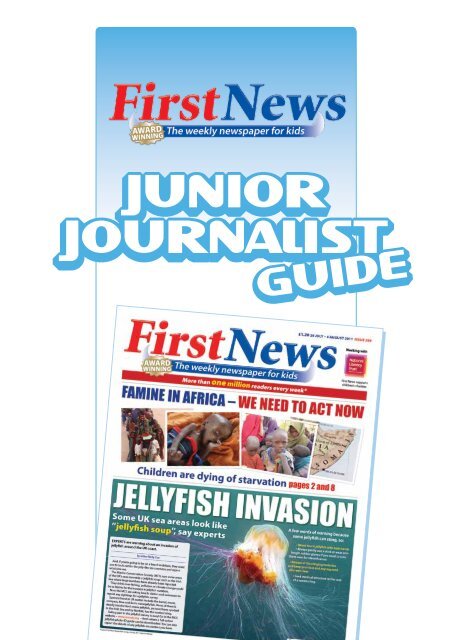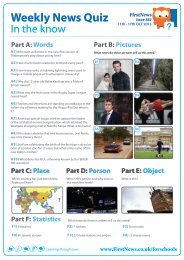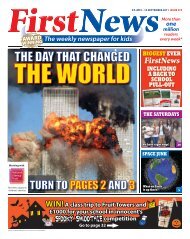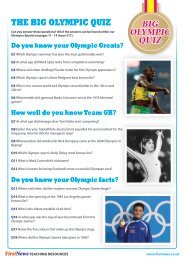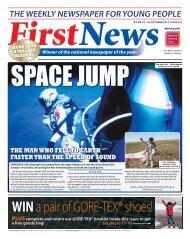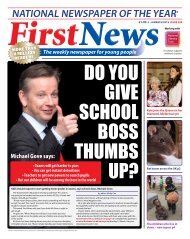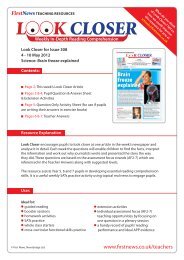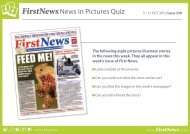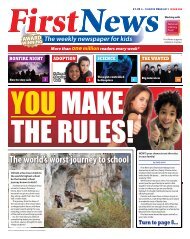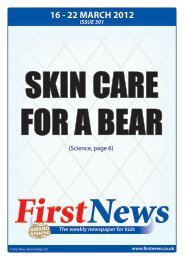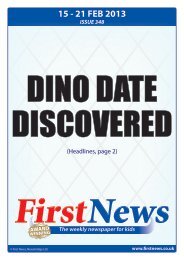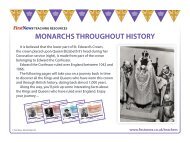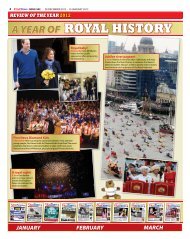JUNIOR JOURNALIST JUNIOR JOURNALIST - First News
JUNIOR JOURNALIST JUNIOR JOURNALIST - First News
JUNIOR JOURNALIST JUNIOR JOURNALIST - First News
You also want an ePaper? Increase the reach of your titles
YUMPU automatically turns print PDFs into web optimized ePapers that Google loves.
<strong>JUNIOR</strong><br />
<strong>JOURNALIST</strong><br />
GUIDE
<strong>First</strong><strong>News</strong><br />
I’m Nicky, Editor of <strong>First</strong> <strong>News</strong>, the award-winning<br />
newspaper for young people in the UK. The <strong>First</strong><br />
<strong>News</strong> team love putting our newspaper together<br />
each week and this booklet will tell you just how it’s<br />
done. You’ll learn everything, from what makes a<br />
good front page to how to edit your work. We hope<br />
you’ll be inspired to write your own newspaper<br />
reports, or maybe even have a go at putting a<br />
whole newspaper together. Most importantly,<br />
we hope you have fun!<br />
Nicky Cox, MBE<br />
Editor, <strong>First</strong> <strong>News</strong><br />
“What you should be doing if you<br />
want to write is keep your eyes,<br />
ears and hearts open and to read<br />
lots of books and newspapers, like<br />
<strong>First</strong> <strong>News</strong>, so that your head is<br />
filled with the world around you.”<br />
Michael Morpurgo<br />
June 2011
<strong>First</strong><strong>News</strong><br />
IN THIS GUIDE<br />
p4-5 What’s on the front page of a newspaper?<br />
p6-7 What’s in a newspaper report?<br />
p8-9 What’s in an interview?<br />
p10-11 The perfect headline<br />
p12-13 Essential editing<br />
p14 Top tips for writing a newspaper report<br />
p15 Write your own article!
<strong>First</strong><strong>News</strong><br />
what’s on the<br />
front page<br />
of a newspaper?<br />
4
<strong>First</strong><strong>News</strong><br />
front page activity<br />
Activity 1 – FRONT PAGE FEATURES<br />
Look at three newspaper front pages and identify the different sections.<br />
Can you find:<br />
the logo?<br />
the cover story?<br />
the headlines?<br />
the masthead?<br />
the teasers?<br />
Tick off each section on the page opposite if you find them on any of your three newspapers.<br />
Do you notice any similarities in the layout between the different newspapers?<br />
Activity 2 – ENGAGING READERS<br />
The front page of a newspaper has to persuade potential readers in a newsagent to pick up<br />
the paper and read it.<br />
What does <strong>First</strong> <strong>News</strong>, and other publications, do on the front page to engage the readers?<br />
Write a list below:<br />
.........................................................................................................................................................................................<br />
.........................................................................................................................................................................................<br />
.........................................................................................................................................................................................<br />
.........................................................................................................................................................................................<br />
.........................................................................................................................................................................................<br />
.........................................................................................................................................................................................<br />
Activity 3 – DESIGN your logo<br />
Design a logo for your own newspaper in the box below.<br />
What name will you give your newspaper? What colours will you use in the logo?<br />
What style will the letters be?<br />
5
<strong>First</strong><strong>News</strong><br />
what’s in a<br />
newspaper report?<br />
6
<strong>First</strong><strong>News</strong><br />
NEWSPAPER REPORT activity<br />
Activity 1 – Leads<br />
Write the lead paragraph for this newspaper report using the following information. Remember,<br />
include the most important and interesting information to summarise the story.<br />
WHO – Mrs Green, an eighty-year-old grandma from Basingstoke<br />
WHAT – Stopped a thief by tripping him over using her walking stick<br />
WHERE – Basingstoke city centre<br />
WHEN – 12 June 2011<br />
WHY – He tried to steal her handbag<br />
.........................................................................................................................................................................................<br />
.........................................................................................................................................................................................<br />
.........................................................................................................................................................................................<br />
.........................................................................................................................................................................................<br />
Activity 2 – Captions<br />
Look at the pictures below. Make up a suitable caption to put under each one.<br />
.........................................................................................................................................................................................<br />
.........................................................................................................................................................................................<br />
.........................................................................................................................................................................................<br />
Activity 3 – DIRECT Quotes<br />
Direct quotes help to bring a story to life and add eye-witness viewpoints. As a journalist, when you<br />
are researching a story you will collect more quotes than you need. The skill is to pick out the best,<br />
most interesting ones for your report.<br />
Which two of these quotes would you include in an article about comedian David Walliams charity<br />
sponsored swim in the River Thames for Sport Relief. Put a tick by your choices.<br />
“What a momentous occasion!” commented a bystander in the crowd.<br />
After his swim, David Walliams said, “I think a bath is the only water I want to see for a while!”<br />
“He’s done an amazing thing” said Stan from Bicester. “We’ve come to cheer David on, see the<br />
sights and have a picnic.”<br />
“It is an unbelievable feat to swim such a long way. The effort David has made to raise over<br />
£1million is very much appreciated,” said a spokesperson from Sport Relief.<br />
7
<strong>First</strong><strong>News</strong><br />
What’s IN an Interview?<br />
Headline<br />
The title should summarise<br />
the story and grab the readers<br />
attention. It could also be<br />
an engaging quote from the<br />
interview.<br />
Introductory Sentence<br />
A brief introduction to<br />
introduce the interviewee and<br />
to explain why they are being<br />
interviewed.<br />
Photograph or Image<br />
This could be of the<br />
interviewee or of the topic<br />
they are talking about in<br />
the interview.<br />
Interview<br />
Questions<br />
The questions the<br />
journalists asked<br />
are included.<br />
Interview<br />
Answers<br />
The responses given<br />
by the interviewee<br />
form the majority of<br />
the interview. These<br />
are ‘tidied up’ by the<br />
journalist as people<br />
don’t always speak in<br />
full sentences. They<br />
also need to put in<br />
punctuation to ensure<br />
the answers are clear<br />
to read. The journalist<br />
does not need to<br />
include everything that<br />
was recorded, but they<br />
can’t add information<br />
or invent things they<br />
would have liked the<br />
interviewee to say!<br />
I love his Richard Branson-esque quality<br />
WE interviewed Eddie Izzard to find what it’ s like to be the<br />
voice of Sir Miles Axlerod in the brilliant Cars 2!<br />
What do you like the most about<br />
your character?<br />
I love the Richard Branson-esque<br />
quality of Miles. I like his style and his<br />
love of great new ideas, even though<br />
there is a twist to my character that<br />
takes him to a different place. He’s<br />
been a lot of fun to play.<br />
Did you have Richard Branson<br />
in mind when you recorded the<br />
dialogue for your character?<br />
The idea of Richard Branson<br />
was mentioned early on in the<br />
production and I definitely identify<br />
with the businessman in Sir Miles<br />
Axlerod, so the character was a great<br />
fit. I love his style of doing business<br />
and the idea of being very positive<br />
while thinking outside of the box.<br />
How difficult is it to work in the<br />
sound booth alone?<br />
This is my fourth animated movie,<br />
so I’ve gotten used to it by now.<br />
You have to tap into that childlike<br />
sensibility you had when you were a<br />
little kid, because you’re imagining<br />
the entire world of Cars 2. Even<br />
though you’re standing<br />
alone in a little space, you have to<br />
imagine you’re standing alongside all<br />
these wonderful characters.<br />
What is it like to visit Pixar<br />
Animation Studios in California?<br />
It’s amazing. You feel like you’re<br />
walking into a whole new world<br />
when you step inside Pixar. The<br />
animators are allowed to decorate<br />
their work areas however they want<br />
to, so you see their imagination<br />
come to life as you wander around<br />
the place. It’s very exciting. It’s<br />
certainly not a drab, gray business<br />
office. There’s a lot of life and<br />
imagination there.<br />
Cars 2 is out now on Disney Blu-ray<br />
and DVD. Go to www.firstnews.<br />
co.uk now to watch the trailer.<br />
Concluding<br />
Sentence<br />
A brief sentence<br />
explaining<br />
where you can<br />
find out more<br />
about the<br />
interviewee or<br />
the main item<br />
being discussed<br />
in the interview.<br />
In magazines<br />
and<br />
newspapers, if<br />
a film, book or<br />
TV programme<br />
is being<br />
promoted, the<br />
details will be<br />
‘plugged’ here.<br />
Interview Writing Timeline<br />
Step One<br />
THE PREPARATION<br />
Find an interesting person with a<br />
story to tell (they’ve acted in a film,<br />
climbed a mountain for charity, have an<br />
interesting job or pet, etc.) to interview.<br />
Write a set of questions that should<br />
give interesting answers. Put them in a<br />
logical order.<br />
Practice saying your questions so you<br />
almost know them off by heart.<br />
Find a sound recording device.<br />
Step Two<br />
THE INTERVIEW<br />
Set up your recording device to<br />
record the interview.<br />
Ask your questions.<br />
Listen very carefully to what your<br />
interviewee says. You may need to ask<br />
an additional question, such as ‘why<br />
….?’, to explain something they say in<br />
an answer.<br />
Make sure you ask all your questions.<br />
Take a photograph.<br />
8<br />
Step Three<br />
THE WRITE UP<br />
Listen back to your interview and<br />
transcribe it (write it down) word-forword.<br />
Choose the most interesting<br />
questions and answers to include in<br />
your write up of the interview.<br />
Tidy up the answers given by<br />
removing unneeded spoken words and<br />
pauses. Put in punctuation needed to<br />
make it easy to read.<br />
Write your introductory and<br />
concluding sentences, and a headline.
<strong>First</strong><strong>News</strong><br />
interview activity<br />
Activity 1 – OPEN & Closed questions<br />
In an interview, a journalist will use open questions that encourage the person being interviewed to<br />
talk. They will not usually use closed questions. Closed questions can be answered by just YES or NO<br />
and these answers would not be very interesting to read in an interview in a newspaper!<br />
Can you identify open and closed questions? Read these questions and tick the relevant box.<br />
Open Closed<br />
Are you pleased with the book you have written?<br />
What is your new book is about?<br />
Why do you think your football team didn’t win their match yesterday?<br />
Will you be starring in any other films this year?<br />
Did you raise a lot of money for charity?<br />
What other films can we watch you in this year?<br />
Activity 2 – WRITING interview questions<br />
Write six questions that you could use to interview wildlife TV presenter, Steve Backshall, about his TV<br />
series Deadly 360 which finds out about some of the world’s most fearsome predators.<br />
1. .....................................................................................................................................................................................<br />
2. .....................................................................................................................................................................................<br />
3. .....................................................................................................................................................................................<br />
4. .....................................................................................................................................................................................<br />
5. .....................................................................................................................................................................................<br />
6. .....................................................................................................................................................................................<br />
Activity 3 – TIdy up these transcrips<br />
After an interview, the journalist writes up the interview word for word. They have to tidy it up and<br />
transform it from the spoken word of the interview into the written word that can be easily read in a<br />
newspaper.<br />
Can you add the punctuation and capital letters that are needed to make diver Tom Daley’s<br />
responses to these interview questions clear and easy to understand?<br />
When you first started diving, what did you<br />
think of it?<br />
I found it scary that was the main thing it’s a really<br />
scary thing to do and when you’re stood on<br />
the edge of a 10m diving board it’s a long way<br />
down but once you do it once it’s a lot of fun<br />
How do you start learning a new dive?<br />
you start on a trampoline learning the basics of<br />
it then you learn in a harness then you have to<br />
learn it off the lower boards and just gradually<br />
work your way up adding extra somersaults as<br />
you go it takes a long time a couple of months to<br />
learn a new dive<br />
9
<strong>First</strong><strong>News</strong><br />
THE PERFECT HEADLINE<br />
What JOB DOES A HEADLINE DO?<br />
Headlines simply tell the news story in as few words as possible. They try to engage the reader and<br />
make them want to read the whole article to find out more.<br />
Generous kids visit Downing Street<br />
Health fears for children caught in Pakistan floods<br />
Pets abandoned<br />
Desert mystery<br />
Every word counts in a headline and any unnecessary words are left out.<br />
For example:<br />
Libya celebrates the future after the death of Colonel Gaddafi<br />
A baby is found alive two days after the earthquake in Turkey<br />
WRITING THE PERFECT HEADLINE<br />
A perfect newspaper headline also sounds good! This helps to grab the reader’s attention and<br />
hook them into the story. To do this, journalists play with the language in the headline. Tricks of<br />
the headline-writing-trade include puns, rhymes, well-known phrases, cliches, song references,<br />
alliteration and assonance. Rhythm and puctuation also play an important role in making a good<br />
headlines. Here are some examples:<br />
Rhyming words:<br />
Owl on the prowl<br />
Rhymes sound appealing, like mini-poems.<br />
Alliteration:<br />
Bamboo bikes in Britain<br />
Several of the words begin with the same letter.<br />
Puns – altering words:<br />
Baa-rilliant news!<br />
Instead of ‘brilliant news’ for a story about Shaun<br />
the Sheep having new website pages.<br />
Puns – homophones:<br />
Oh dear oh deer<br />
The well-known phrase is altered with a<br />
homophone for a story about problems an<br />
increase in the deer population is causing.<br />
Questions:<br />
Could time travel be real?<br />
Intriguing questions make effective headlines as<br />
you need to read the story to find the answer.<br />
Assonance:<br />
Oil rig spill<br />
The use of similar vowel or consonant sounds in<br />
words near to each other. ‘Heat wave hits India’ is<br />
another example of the use of assonance.<br />
Well-known phrases:<br />
Ready steady Cooke!<br />
A well-known phrase is alterered slightly to fit<br />
the story. The sporty phrase ‘Ready steady go!’<br />
is changed for a report on athlete Jamie Cooke<br />
winning the pentathlon.<br />
Designed to cause shock & intrigue:<br />
I was constantly upside down!<br />
With these type of headlines the reader can’t<br />
resist reading to find out the details in the story.<br />
10
<strong>First</strong><strong>News</strong><br />
HEADLINE activity<br />
Activity 1 – Headline HOOKs<br />
Read the headlines below. Think about and discuss:<br />
i) Which ones do you like best? Why?<br />
ii) Which stories would you be hooked into reading first? Why?<br />
iii) All these are headlines from <strong>First</strong> <strong>News</strong>. What might the story behind the headline be?<br />
Taste not waste<br />
Nuns learn karate to protect convent<br />
Un-bee-lievable<br />
Clever fish caught on camera<br />
Fingertip grows from stomach<br />
Can weather start a war?<br />
Headline techniques used<br />
Now, identify and write down the headline techniques the journalists have used.<br />
Activity 2 – SHORT & SNAPPY<br />
Get rid of the unnecessary words to make these headlines as short and snappy as possible.<br />
Cross out the unneeded words.<br />
Very rare sea horses have been found in the River Thames<br />
Pandas are on their way to Scotland from China<br />
Activity 3 – Write THE HEADLINES<br />
Write two possible headlines for each of these stories. Try out different techniques and try to<br />
improve on your first ideas.<br />
Story A<br />
Teachers at Netherthorpe School in Chesterfield might think they have double vision… there are<br />
nine sets of twins in Year 7!<br />
Headline 1 ..................................................................................................................................................................................<br />
Headline 2 ..................................................................................................................................................................................<br />
Story B<br />
US president Barack Obama said that the framed crocodile insurance policy he received this week<br />
was the “most unigue gift” he’s ever had.<br />
Headline 1 ..................................................................................................................................................................................<br />
Headline 2 ..................................................................................................................................................................................<br />
Story C<br />
Two species of manta rays, the gentle giants of the sea, have been added to the International Union<br />
for the Conservation of Nature Red list, meaning they are a vulnerable species.<br />
Headline 1 ..................................................................................................................................................................................<br />
Headline 2 ..................................................................................................................................................................................<br />
Now, identify the best headline you have come up with for each story. Turn to page 14 to find out the<br />
headlines the journalists from <strong>First</strong> <strong>News</strong> wrote for these stories.<br />
11
<strong>First</strong><strong>News</strong><br />
ESSENTIAL EDITing<br />
IS YOUR WRITING ready for publishing?<br />
Editing is an essential part of writing for newspapers. It is really important that no mistakes<br />
go unnoticed and end up being printed in the paper. Errors in an article distract the reader<br />
and can make it difficult to understand the story.<br />
Here are examples of common errors to look out for:<br />
Common<br />
Punctuation Mistakes<br />
When you are<br />
concentrating on the<br />
content of your writing, it<br />
is easy to miss out or add<br />
unnessary apostrophes.<br />
Always double check that<br />
all apostrophes are in the<br />
right place.<br />
‘... it’s oil..’ does not need<br />
one as this word is not<br />
short for ‘it is’.<br />
Common<br />
Spelling Mistakes<br />
It is also easy to muddle<br />
homophones. Always<br />
double check them<br />
when editing.<br />
Leek is the vegetable.<br />
The spelling should be<br />
‘leak’ here meaning ‘a spill<br />
from a hole’.<br />
Last Minute<br />
Improvements<br />
Try not to repeat key<br />
words or phrases. Try to<br />
write them in a different<br />
way. ‘Around’ was used to<br />
start the third paragraph.<br />
Use a word like<br />
‘approximately’ instead to<br />
start the fifth paragraph.<br />
Oil pumped off<br />
stranded cargo ship<br />
A GIANT cargo ship which got stuck<br />
a reef off the coast of new zealand<br />
has had all it’s oil pumped off to<br />
avoid an ecological disaster.<br />
Salvage teams decided to carry out the<br />
tricky operation as the ship the Rena was in<br />
danger of breaking apart.<br />
Around 1,000 sea birds has already been<br />
killed by an oil leek, but many more birds<br />
along with other marine life would have<br />
been at risk from the oil.<br />
The ship is stranded in the Bay of Plenty,<br />
an area afmous for its wildlife, including<br />
dolphins and ppenguins, and also its long<br />
sandy beaches.<br />
Around 1,300 containers are still on board<br />
and a special crane will start removing<br />
these too.<br />
The ship ran aground on a reef last month.<br />
The captain and second-in-charge may<br />
face prosicution.<br />
Typos<br />
What exactly have<br />
you written?!<br />
It is easy to miss out<br />
words that you think<br />
you have written or to<br />
accidently repeat a word.<br />
Here, the word ‘on’ is<br />
missing from the first<br />
sentence. It should say ‘...<br />
stuck on a reef..’<br />
Capital letters<br />
These are needed for the<br />
beginning of each<br />
sentence and also for<br />
proper nouns – the names<br />
of people, places and<br />
institutions.<br />
The country ‘New Zealand’<br />
needs capital letters.<br />
Punctuation<br />
As well as full stops,<br />
question marks or<br />
exclamation marks at the<br />
end of every sentence,<br />
check for commas needed<br />
for lists, additional<br />
information and phrases.<br />
Commas are needed<br />
around ‘the Rena’ as it is<br />
additional information<br />
about the ship - ‘...the ship,<br />
the Rena, was in danger ..’<br />
Grammar<br />
Dictionary Check<br />
Always check the spellings<br />
of any words you are<br />
uncertain of in a dictionary.<br />
‘Prosicution’ should be<br />
‘prosecution’.<br />
Typing errors can happen easily.<br />
The letters in ‘famous’ have been typed in<br />
the wrong order and there is an extra ‘p’<br />
at the beginning of ‘penguin’.<br />
12<br />
Check you have used<br />
the correct verb forms<br />
for singular and plural<br />
subjects.<br />
Here, ‘has’ should be ‘have’.
<strong>First</strong><strong>News</strong><br />
EDITING activity<br />
How good are you at finding errors?<br />
Now it’s your turn. Edit this science article.<br />
Use the Editing Checklist to help you and to identify the type of error.<br />
Editing checklist<br />
1. Have you told the whole story accurately?<br />
2. Can you make any last minute improvements?<br />
3. Have you written exactly what you think you’ve written?<br />
4. Have you done a dictionary check?<br />
5. Have you checked your grammar?<br />
6. Is all your punctuation in place?<br />
7. Do you have all the capital letters needed?<br />
8. Check for common spelling mistakes, e.g. muddled homophones.<br />
9. Check for common punctuation mistakes, e.g. unneeded apostrophes.<br />
10. Check for typing mistakes.<br />
Tick when<br />
checked<br />
P<br />
P<br />
Can you find the 16 errors? Annotate the article and make a note of the changes that<br />
would be needed before printing.<br />
P1<br />
What goes up might<br />
come down<br />
as <strong>First</strong> <strong>News</strong> went to press, the russians was<br />
desperately trying to make contact with there<br />
Mars probe, which is stuck in orbit around Earth.<br />
P2<br />
P3<br />
P4<br />
P5<br />
How the Phobos-Grunt<br />
probe should have looked<br />
as it approached Mars<br />
The Russian Federal Space Agency (Roscosmos)<br />
launched the the Phobos-Grunt spacecraft on 8<br />
November. Unfortunatly once the craft reached orbit<br />
and seperated from its launch rocket, the probe’s thrusters failed to fire.<br />
A Russian official said that the agency have two weeks to try to fix the problem, before<br />
the probe lost for good.<br />
The spacecraft has two parts. One was due to orbit Mars, while the other was supposed<br />
to head to the surface of the red planets largest moon, Phobos once there, it wood take<br />
soil sample’s and return them to Earth in a tiny rrocket.<br />
Latest reports suggest that things aren’t looking good for the the mission, but check<br />
www.firstnews.co.uk/discover to find out whether negineers figure out the problem.<br />
13
<strong>First</strong><strong>News</strong><br />
TOP TEN TIPS FOR WRITING<br />
A NEWSPAPER REPORT<br />
ANSWERS Page 11 Activity Three: the headlines <strong>First</strong> <strong>News</strong> journalists chose – A. It’s twin-credible B. Peculiar present C. Vulnerable giants.<br />
Page 13 The 16 errors P1: capital letter for Russians; grammar error - the Russians were desperately; homophone spelling error - their Mars probe,<br />
P2: spelling errors - unfortunately & separated; punctuation error - comma needed after unfortunately .. Unfortunately, once the ...<br />
P3: grammar error - the agency has two weeks; missing word - before the probe is lost for good<br />
P4: missed apostrophe - the red planet’s largest moon; full stop and capital letters missing to mark new sentence - ... largest moon, Phobos. Once<br />
there, it... ; homophone spelling error - it would take; unnecessary apostrophe - soil samples; typo - tiny rocket<br />
P5: repeated word - for the the mission; typo - engineers<br />
14
<strong>First</strong><strong>News</strong><br />
WRITE YOUR OWN ARTICLE<br />
Now, it’s your turn to be the journalist and write a news report.<br />
Step one: plan your article<br />
What are you going to write about? E.g. a charity event, a school trip, etc.<br />
.......................................................................................................................................................................................................<br />
Who would want to read this article? E.g. your school, local community, etc.<br />
.......................................................................................................................................................................................................<br />
Lead Paragraph<br />
Who? What? Where? When? Why? How?<br />
Paragraph 2<br />
Paragraph 3<br />
Paragraph 4<br />
Quote<br />
Which paragraph will this go in?<br />
Photograph<br />
Headline<br />
Step TWo: WRITE your article<br />
.................................................................................................<br />
.................................................................................................<br />
.................................................................................................<br />
.................................................................................................<br />
.................................................................................................<br />
.................................................................................................<br />
.................................................................................................<br />
.................................................................................................<br />
.................................................................................................<br />
.................................................................................................. ......................................................................................................<br />
.................................................................................................. ......................................................................................................<br />
.................................................................................................. ......................................................................................................<br />
.................................................................................................. ......................................................................................................<br />
8<br />
15
<strong>First</strong><strong>News</strong><br />
Subscribe to first news<br />
at home<br />
GET 4 issues<br />
for £1!*<br />
Every week <strong>First</strong> <strong>News</strong> features:<br />
World and UK <strong>News</strong><br />
Entertainment<br />
Books, puzzles & competitions<br />
The environment and animals<br />
Sports, fitness and health<br />
Crazy but true stories<br />
Puzzles and competitions<br />
Plus much more!<br />
Subscribe today and get:<br />
Your first 4 issues for £1, followed by £13.99 every three months on Direct Debit<br />
<strong>First</strong> <strong>News</strong> delivered each week direct to your door<br />
FREE post & packaging<br />
Easily digestible articles in a child-friendly design<br />
Call: 0844 8267 338<br />
visit: www.firstnews.co.uk/subscribe<br />
(Please quote CU4D when ordering)


